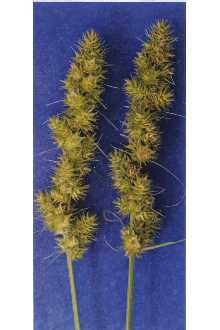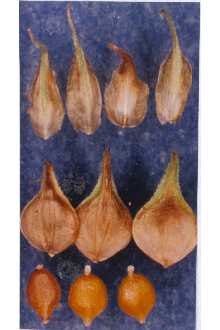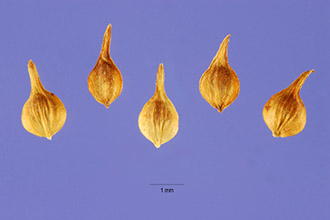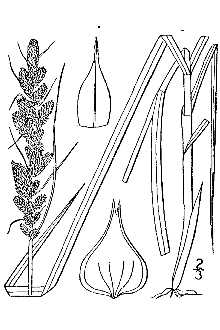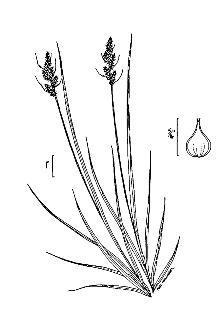Fox Sedge
Scientific Name: Carex vulpinoidea Michx.
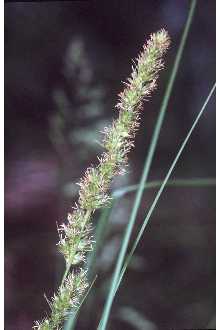
| General Information | |
|---|---|
| Usda Symbol | CAVU2 |
| Group | Monocot |
| Life Cycle | Perennial |
| Growth Habits | Graminoid |
| Native Locations | CAVU2 |
Plant Guide
Alternate Names
Common fox sedge, two varieties are reported for the U.S.: Carex vulpinoidea var pycnocephala and Carex vulpinoidea var. vulpinoidea.
Uses
Landscaping: Fox sedge is used as an ornamental grass near water gardens. Restoration: Fox sedge is a clumping grass that will naturalize where planted. It is planted in locations that remain moist, near streams, springs, ponds, and moist woods. It is an excellent colonizer of wetland mitigation sites.
Weediness
Fox sedge spreads rapidly and may be weedy or invasive in some regions or habitats, displacing desirable vegetation if not properly managed. Please consult with your local NRCS Field Office, Cooperative Extension Service office, or state natural resource or agriculture department regarding its status and use. Weed information is also available from the PLANTS Web site at plants.usda.gov. The USDA hardiness zones for fox sedge are 3-7. It is a pioneer species that colonizes wet open sites soon after disturbance. It grows in full sun to part shade and likes normal to wet soils. It is most abundant in clayey soils, but also does well in sand and loam.
Description
General: Sedge Family (Cyperaceae). Fox sedge is a perennial, clump-forming grass that grows to be 30 to 100 cm tall and spreads up to 60 cm wide. This is a U.S. native. Stems are slender and firm, triangular, brownish at the base and have whitish, thin sheaths that are conspicuously cross-wrinkled near the top. The leaves are narrow, 0.6 cm wide, smooth with rough margins, clustered at the base of the plant and usually taller than the stem, growing up to 1.2 m tall. The inflorescences are made up of densely flowered spikes that are 4 to 10 cm long and up to 1.5 cm wide. Bristle-like bracts, up to 5 cm long, are located at the base of each spike. Staminate flowers are at the top of the spike and pistillate flowers are at the base. The flowers are green and bloom from May through June. The seedheads mature in late summer and spray out from the center of the clump, resembling a fox’s tail. The distinctive inflorescence makes fox sedge easy to identify. R.W. Freckman 2004 Wisconsin State Herbarium. Distribution: Fox sedge is a native species and has been reported in all but two of the continental United States, Nevada and Utah. For current distribution, please consult the Plant Profile page for this species on the PLANTS Web site (http://plants.usda.gov). Habitat: Fox sedge is found near water on moist open ground in swamps, prairie swales, lowland forests, wet ditches, ravines, and along the edges of marshes, springs, lakes, and ponds. It is found with other plant species such as soft rush, wool grass, bulrush, other sedges, brome grass, Virginia wild rye, ox eye daisy, boneset, pye weed, ironweed, golden alexanders, sneezewood, and monkey flower.
Adaptation
Establishment
Fox sedge seedlings should be spaced 1 to 2 feet apart. This converts to approximately 1000 roots per acre.
Seeds and Plant Production
Plant Production , Use soil moisture sensors to measure the soil moisture of Fox Sedge.
Plant Production
Seeds are ready for collection when the inflorescences turn brown and the fruits can be easily pulled from the spikes. Fresh seeds should be planted in the fall or moist-stratified and planted in the spring. Cultivars, Improved, and Selected Materials (and area of origin) Fox sedge seeds and some seedlings are readily available from commercial sources. The USDA-NRCS Plant Materials Program has not released any fox sedge cultivars for conservation use. Contact your local Natural Resources Conservation Service (formerly Soil Conservation Service) office for more information. Look in the phone book under ”United States Government.” The Natural Resources Conservation Service will be listed under the subheading “Department of Agriculture.”
Control
Please contact your local agricultural extension specialist or county weed specialist to learn what works best in your area and how to use it safely. Always read label and safety instructions for each control method. Trade names and control measures appear in this document only to provide specific information. USDA, NRCS does not guarantee or warranty the products and control methods named, and other products may be equally effective.
Plant Traits
Growth Requirements
| Temperature, Minimum (°F) | -38 |
|---|---|
| Adapted to Coarse Textured Soils | No |
| Adapted to Fine Textured Soils | Yes |
| Adapted to Medium Textured Soils | Yes |
| Anaerobic Tolerance | Medium |
| CaCO3 Tolerance | Medium |
| Cold Stratification Required | No |
| Drought Tolerance | Low |
| Fertility Requirement | Medium |
| Fire Tolerance | Low |
| Frost Free Days, Minimum | 110 |
| Hedge Tolerance | None |
| Moisture Use | Medium |
| pH, Maximum | 8.9 |
| pH, Minimum | 6.8 |
| Planting Density per Acre, Maxim | 19000 |
| Planting Density per Acre, Minim | 10912 |
| Precipitation, Maximum | 65 |
| Precipitation, Minimum | 12 |
| Root Depth, Minimum (inches) | 16 |
| Salinity Tolerance | None |
| Shade Tolerance | Intermediate |
Morphology/Physiology
| After Harvest Regrowth Rate | Slow |
|---|---|
| Toxicity | None |
| Resprout Ability | No |
| Shape and Orientation | Erect |
| Active Growth Period | Spring |
| Bloat | None |
| Coppice Potential | No |
| Fall Conspicuous | No |
| Fire Resistant | Yes |
| Flower Color | Green |
| Flower Conspicuous | No |
| Foliage Color | Green |
| Foliage Porosity Summer | Porous |
| Foliage Porosity Winter | Porous |
| Fruit/Seed Color | Yellow |
| Nitrogen Fixation | None |
| Low Growing Grass | No |
| Lifespan | Long |
| Leaf Retention | No |
| Known Allelopath | No |
| Height, Mature (feet) | 3.2 |
| Growth Rate | Moderate |
| Growth Form | Bunch |
| Fruit/Seed Conspicuous | No |
| Foliage Texture | Fine |
Reproduction
| Vegetative Spread Rate | None |
|---|---|
| Small Grain | No |
| Seedling Vigor | Medium |
| Seed Spread Rate | Moderate |
| Fruit/Seed Period End | Fall |
| Seed per Pound | 1297000 |
| Propagated by Tubers | No |
| Propagated by Sprigs | Yes |
| Propagated by Sod | No |
| Propagated by Seed | Yes |
| Propagated by Corm | No |
| Propagated by Container | No |
| Propagated by Bulb | No |
| Propagated by Bare Root | No |
| Fruit/Seed Persistence | No |
| Fruit/Seed Period Begin | Summer |
| Fruit/Seed Abundance | Medium |
| Commercial Availability | Routinely Available |
| Bloom Period | Spring |
| Propagated by Cuttings | No |
Suitability/Use
| Veneer Product | No |
|---|---|
| Pulpwood Product | No |
| Post Product | No |
| Palatable Human | No |
| Palatable Graze Animal | Medium |
| Nursery Stock Product | No |
| Naval Store Product | No |
| Lumber Product | No |
| Fodder Product | No |
| Christmas Tree Product | No |
| Berry/Nut/Seed Product | No |

